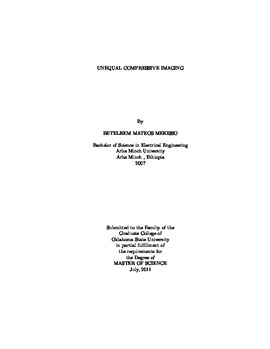| dc.contributor.advisor | Rahnavard, Nazanin | |
| dc.contributor.author | Mekisso, Betelhem Mateos | |
| dc.date.accessioned | 2014-04-17T20:08:56Z | |
| dc.date.available | 2014-04-17T20:08:56Z | |
| dc.date.issued | 2011-07-01 | |
| dc.identifier.uri | https://hdl.handle.net/11244/10243 | |
| dc.description.abstract | Recently, novel compressive sensing (CS) techniques have been employed to concurrently perform compression and image sampling. Since an image has sparse representation in some proper transform basis, such as discrete cosine transform (DCT) and wavelet transform, we can reconstruct it from its undersampled random projections called measurements employing CS techniques. In this thesis, we propose unequal compressive imaging for different scenarios. First, we consider the fact that the area in an image which contains the main subject is more important to the viewer, e.g., the face in a portrait. As a result, we consider the main subject of the images to be the region of interest. We employ an existing algorithm to find the main subject area of the images, and propose to incorporate the coefficients of this area into more number of measurements compared to the rest. With this setup, the region of interest is reconstructed with a better quality, while the less important areas are slightly degraded. Further, we consider the fact that the low frequency coefficients of the sparse representation of an image (that convey most of the image information) mostly appear at the beginning of the sparse representation of the image. Therefore, we propose to use unequal compressive sampling to capture the beginning transform coefficients more strongly than the rest, and show that this would significantly improve the quality of the reconstructed image. Moreover, we exploit the structure of the wavelet tree (which results from the wavelet decomposition) to track the transform coefficients that correspond to the region of interest of images. We then propose an algorithm which strongly captures those transform coefficients that carry most of the image information and also those that correspond to the region of interest. With this setting, the overall quality of the reconstructed image is improved while the region of interest exhibits an even better quality. | |
| dc.format | application/pdf | |
| dc.language | en_US | |
| dc.publisher | Oklahoma State University | |
| dc.rights | Copyright is held by the author who has granted the Oklahoma State University Library the non-exclusive right to share this material in its institutional repository. Contact Digital Library Services at lib-dls@okstate.edu or 405-744-9161 for the permission policy on the use, reproduction or distribution of this material. | |
| dc.title | Unequal Compressive Imaging | |
| dc.type | text | |
| dc.contributor.committeeMember | Chandler, Damon | |
| dc.contributor.committeeMember | Sohoni, Sohum | |
| osu.filename | Mekisso_okstate_0664M_11670.pdf | |
| osu.college | Engineering, Architecture, and Technology | |
| osu.accesstype | Open Access | |
| dc.description.department | School of Electrical & Computer Engineering | |
| dc.type.genre | Thesis | |
| dc.subject.keywords | compressive sensing | |
| dc.subject.keywords | image processing | |
| dc.subject.keywords | region of interest | |
| dc.subject.keywords | unequal compressive sampling | |
